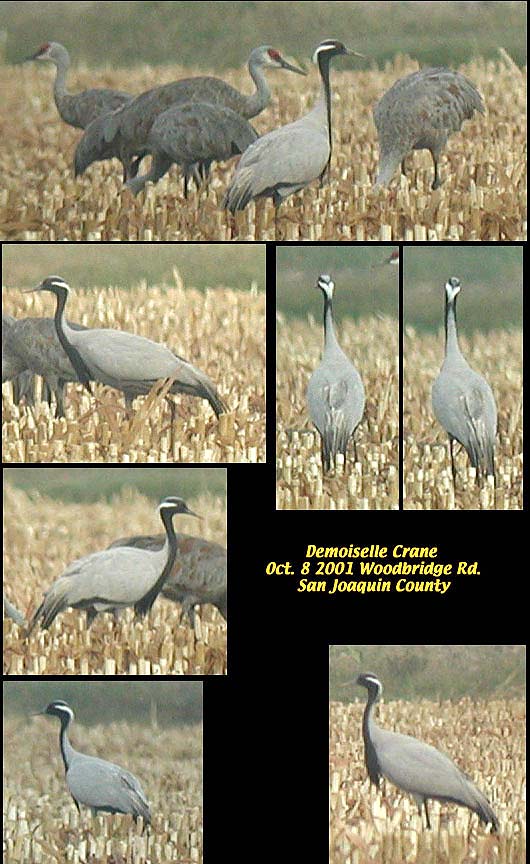Demoiselle Crane
Staten Island Road, San Joaquin County
Saturday, 27 October 2001
Joseph Morlan
 Photos © 2001 Kevin McKereghan
Photos © 2001 Kevin McKereghan
The following description is based on notes made while watching the bird:
An obvious crane, slightly smaller than adjacent Sandhill Cranes, and showing a bold black and white head pattern.
The head and foreneck were black with a bold white plume extending from each eye back across the face to the back of the head, where the white stripes connected. The forehead was black, but the crown was pale gray contrasting with the white head stripes. The bill was dark and appeared relatively small compared to the Sandhill Cranes.
The back of the neck was pale, pearl-gray as was the back and wing coverts. This gray color was much paler than the Sandhill Cranes and the bird appeared decidedly pale in comparison. The belly was also pale gray, contrasting strongly with the black foreneck and breast. The black breast feathers hung loose, forming a bib.
The primaries, secondaries and rectrices were very dark and contrasted strongly with the rest of the wings in flight. While perched, the dark primaries were visible as an "apron" just below the gray wing-coverts, a pattern not evident on the Sandhill Cranes.
The uppertail coverts were very long, forming an extensive "bustle" which appeared black from below, but from above was brownish-gray basally, blending into dark gray distally. Legs and feet were dark gray.
Its posture differed from Sandhill Crane in that it tended to hold its body horizontal while foraging. This pose often resulted in a hunch-backed appearance as the neck extended from below the shoulders. It seemed to be a slimmer and more delicate than the Sandhill Cranes. It flew with a direct flight, wing strokes evenly up and down, lacking the snapping action typical of Sandhill Cranes. Also it held its head and neck down, well below the horizontal while the Sandhill Cranes held their necks straight.
Discussion
There has been considerable dispute over this bird's natural status. There are no previously accepted records for North America, although escaped captives have been seen. The species is highly migratory with populations wintering in India and the Sudan. Its range does not overlap with Sandhill Crane anywhere. It has been recorded as a vagrant in most Western European countries, but some of those records (e.g. Italy) have been suspected of being escapees.
The possibility that this bird is naturally occurring is improbable, but not impossible. Further research is needed. Additional discussion may be found on the Central Valley email list. Some pertinent messages are here, here, and here. Additional photos have been posted here.